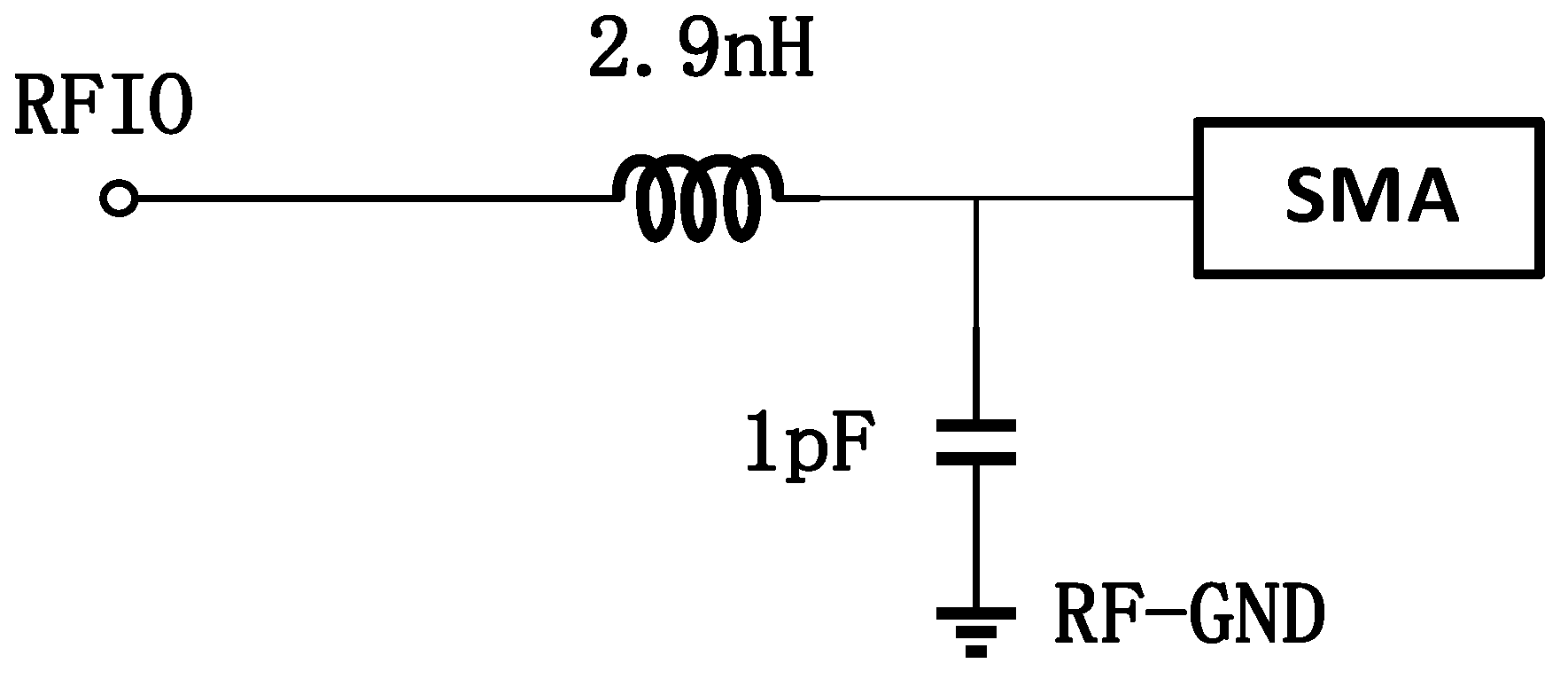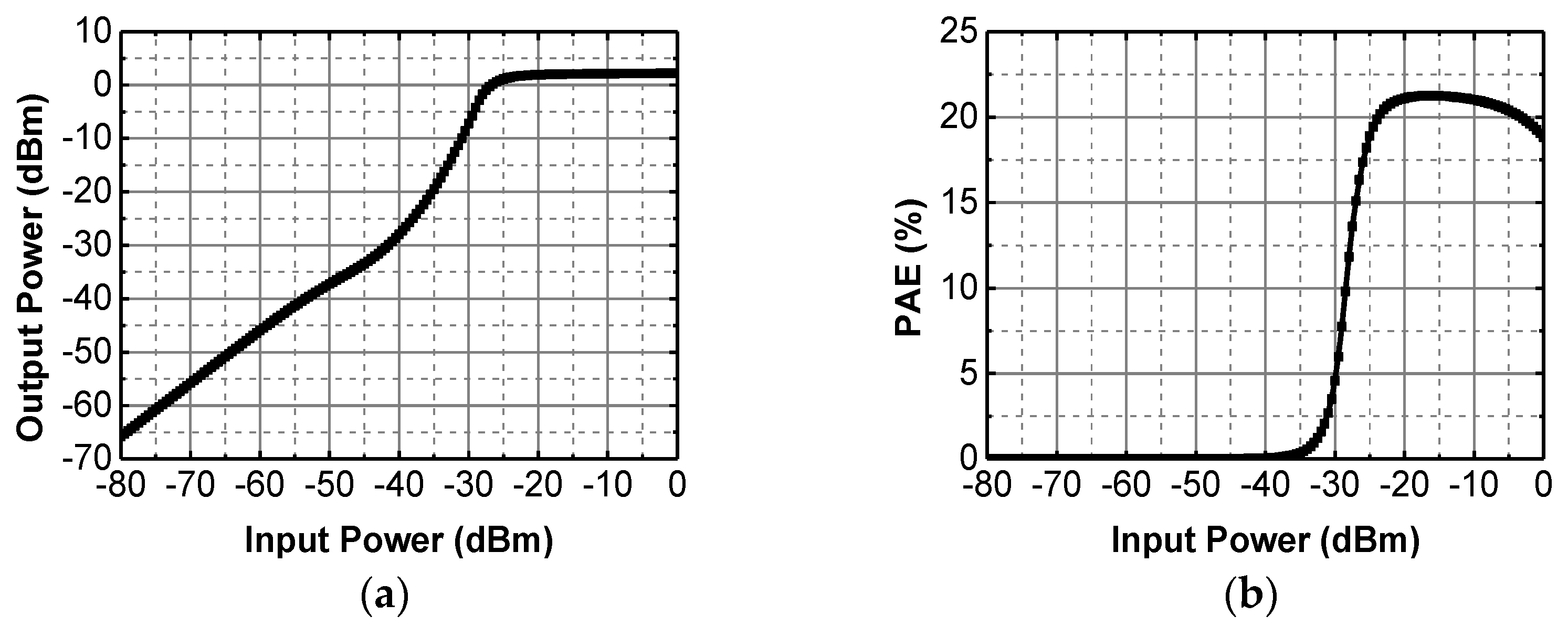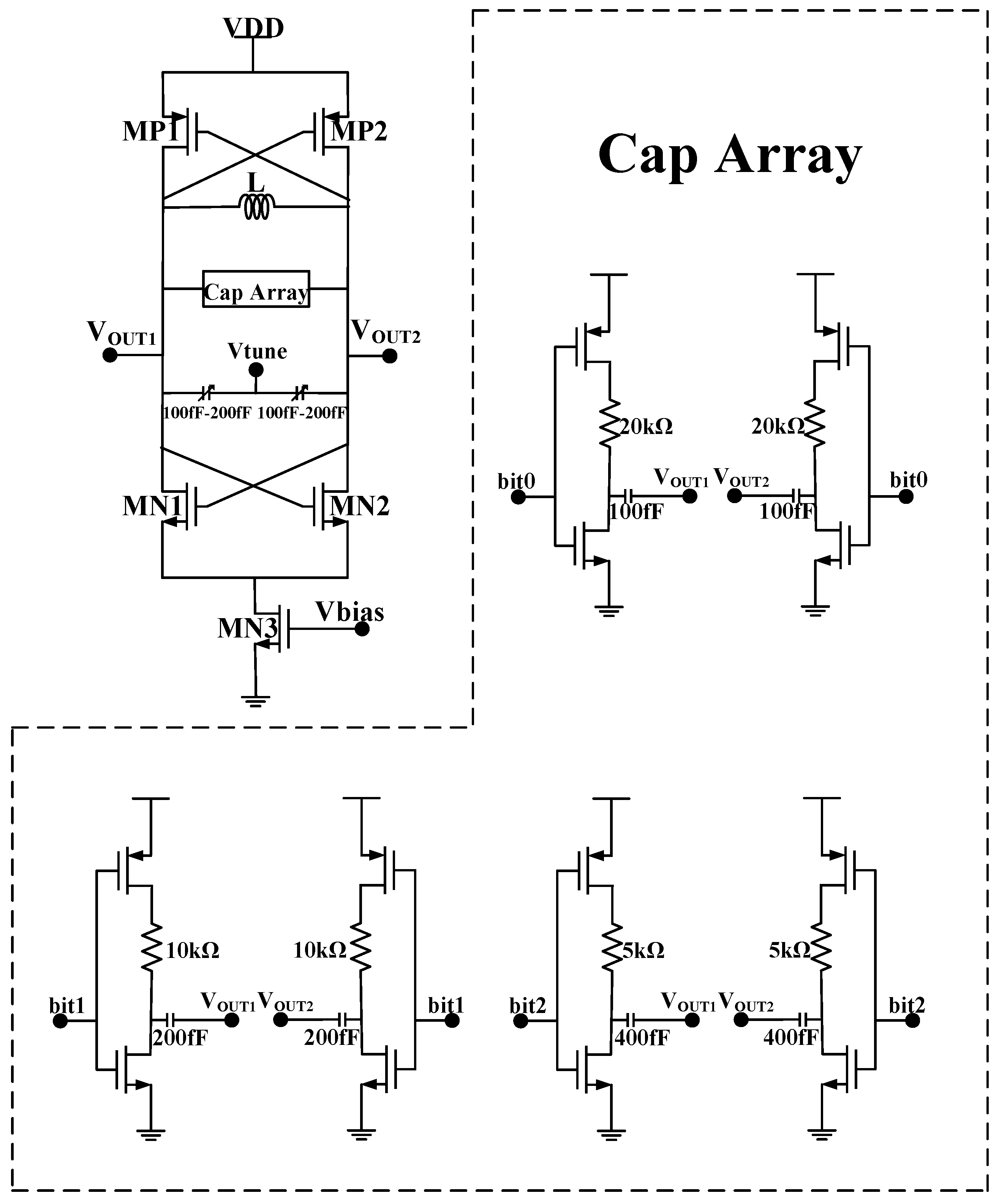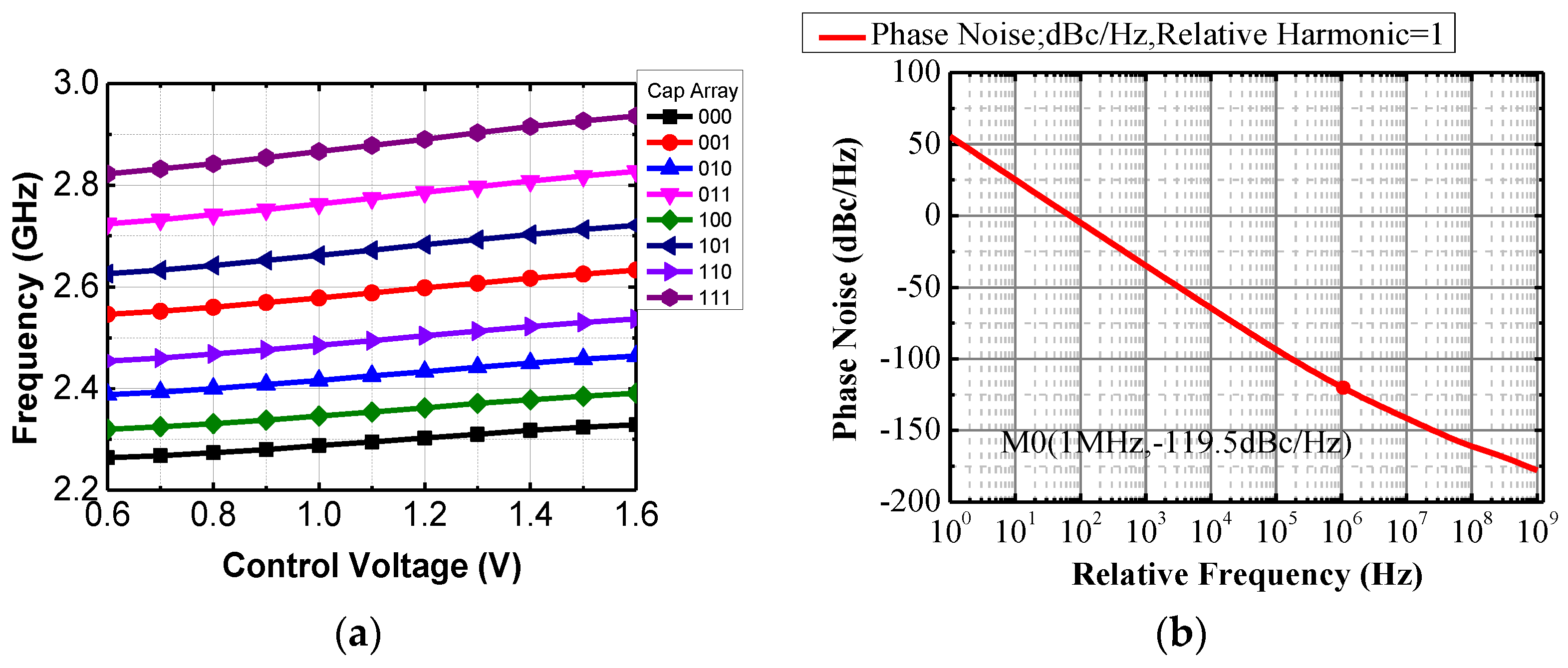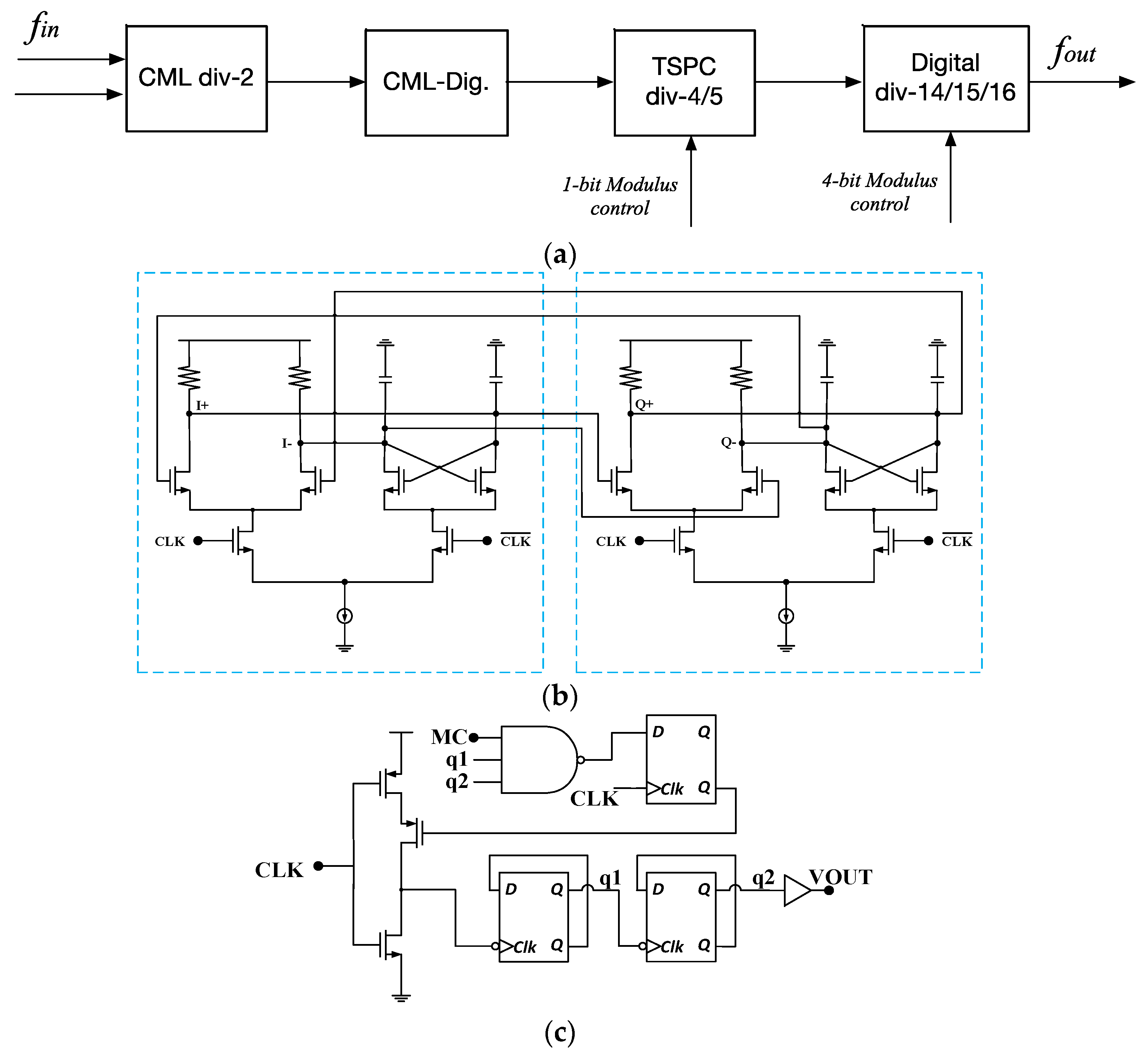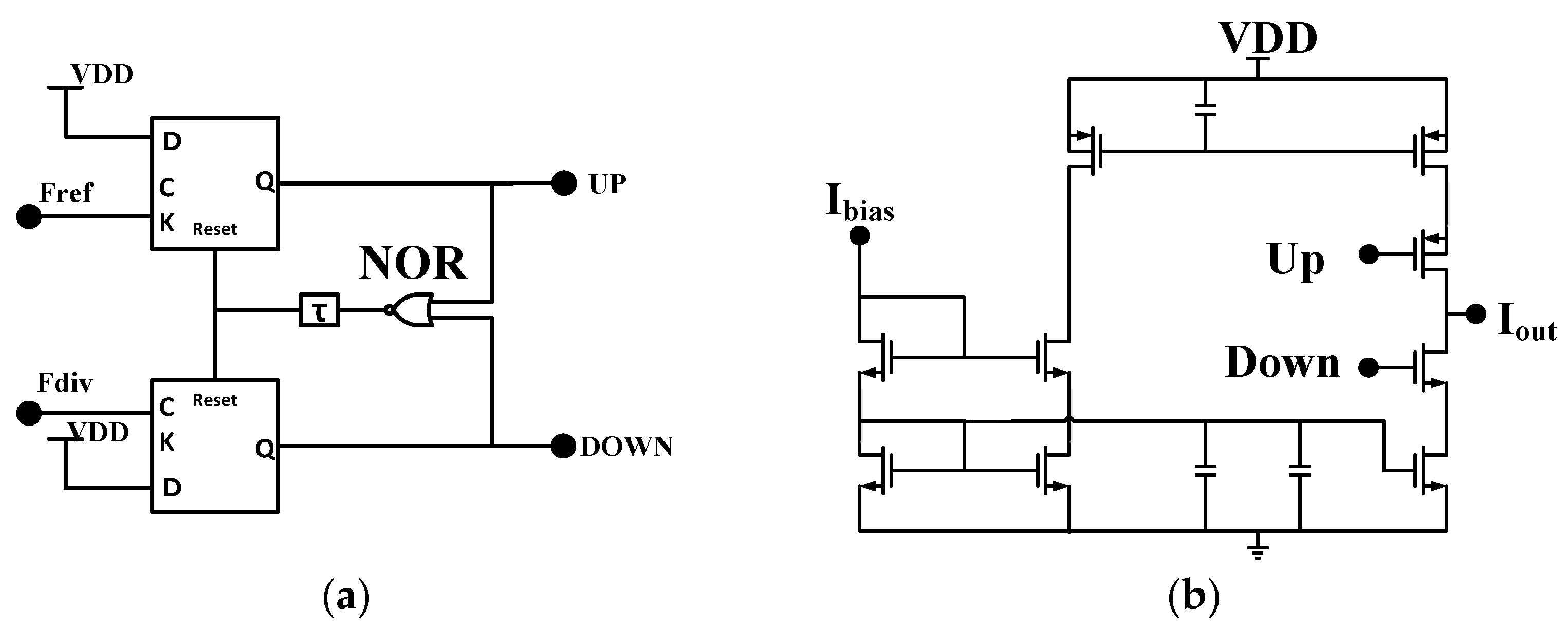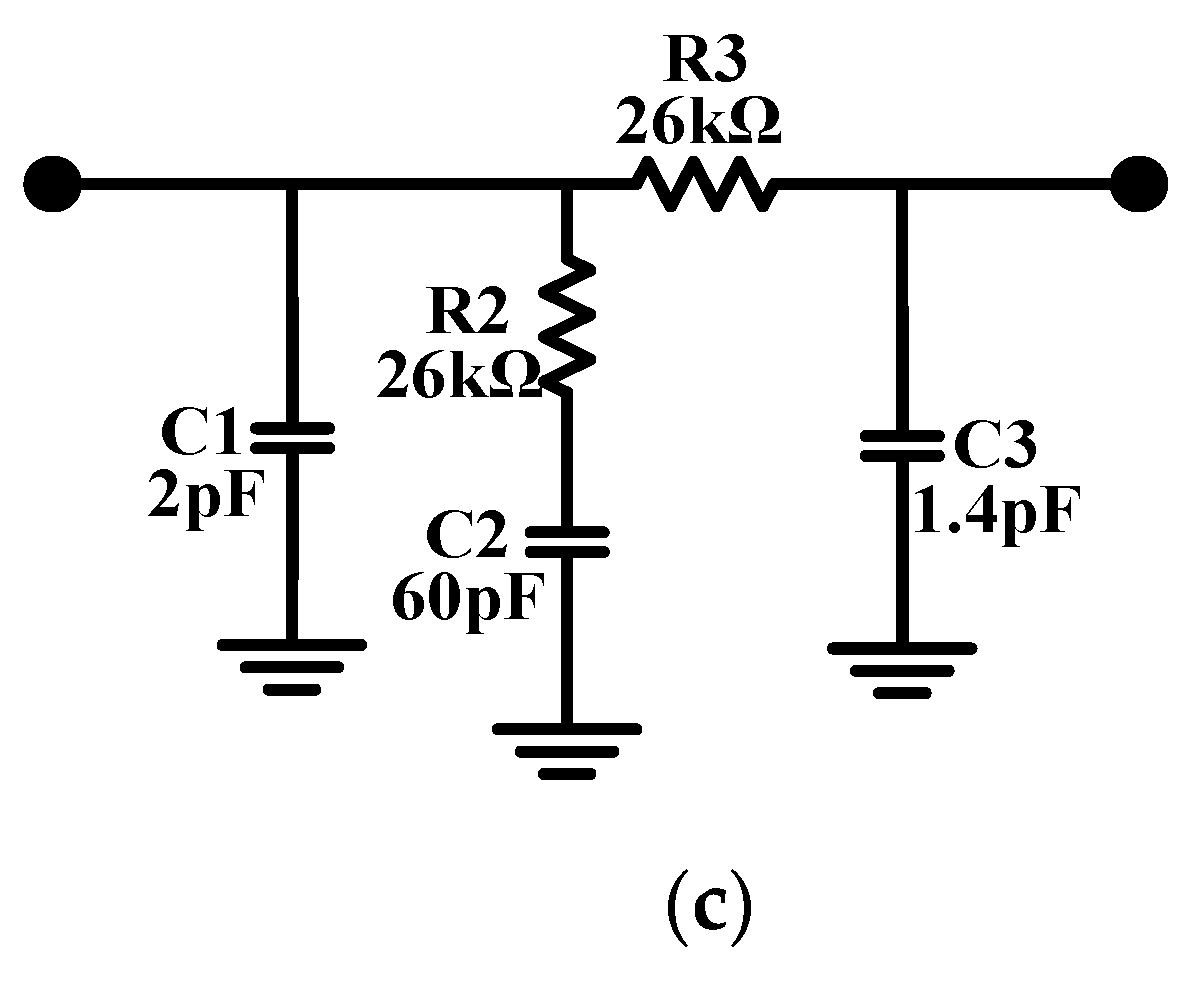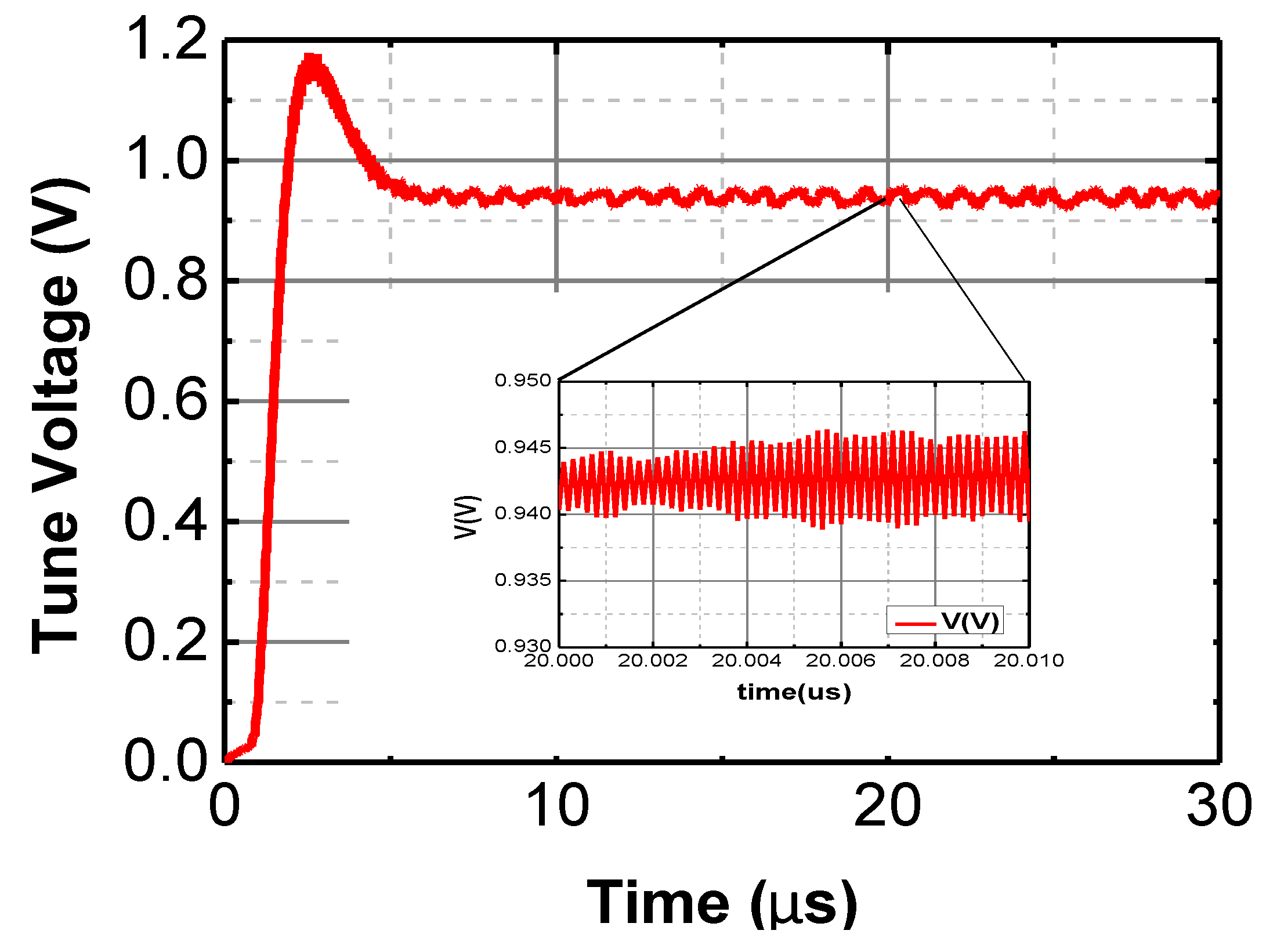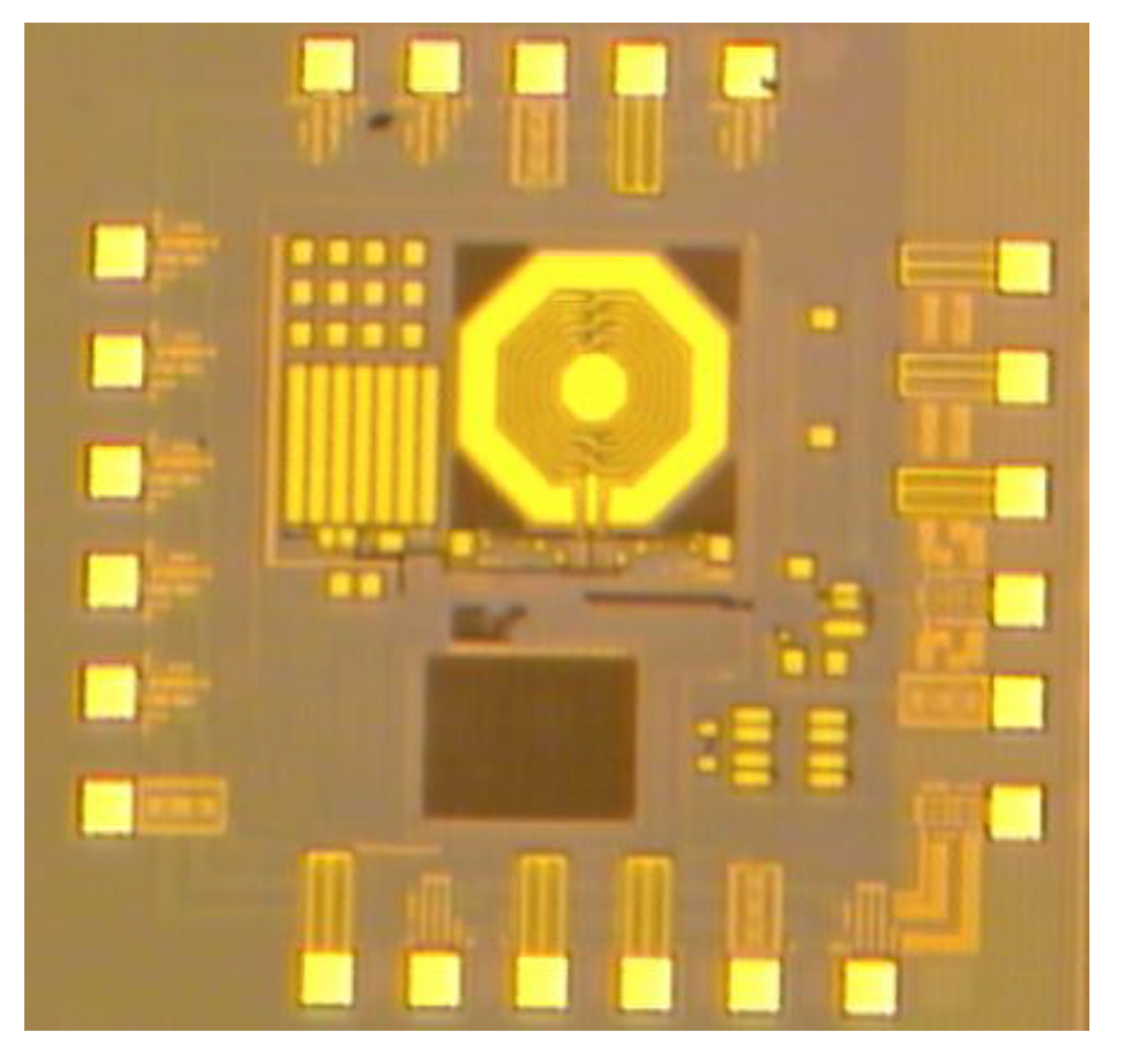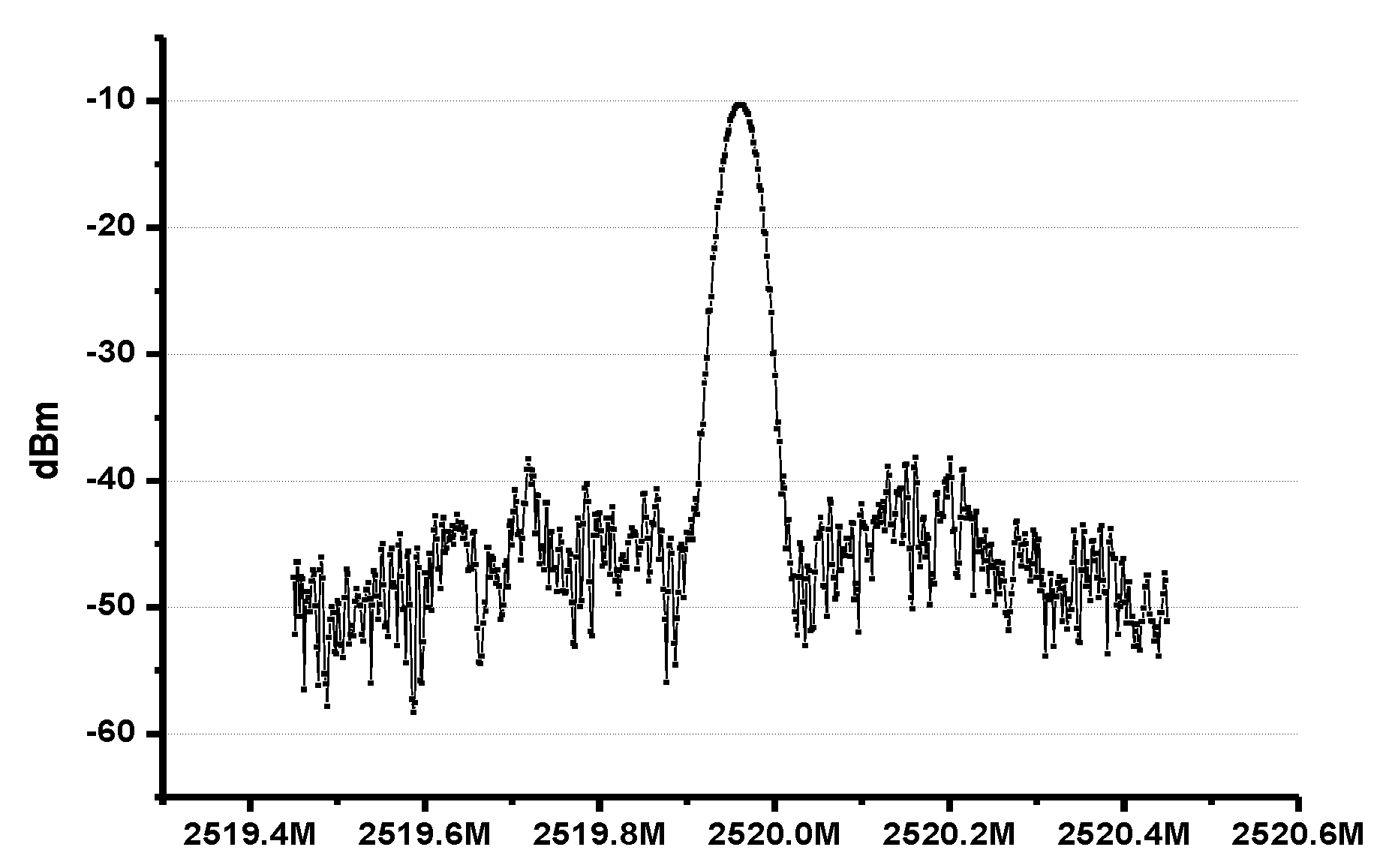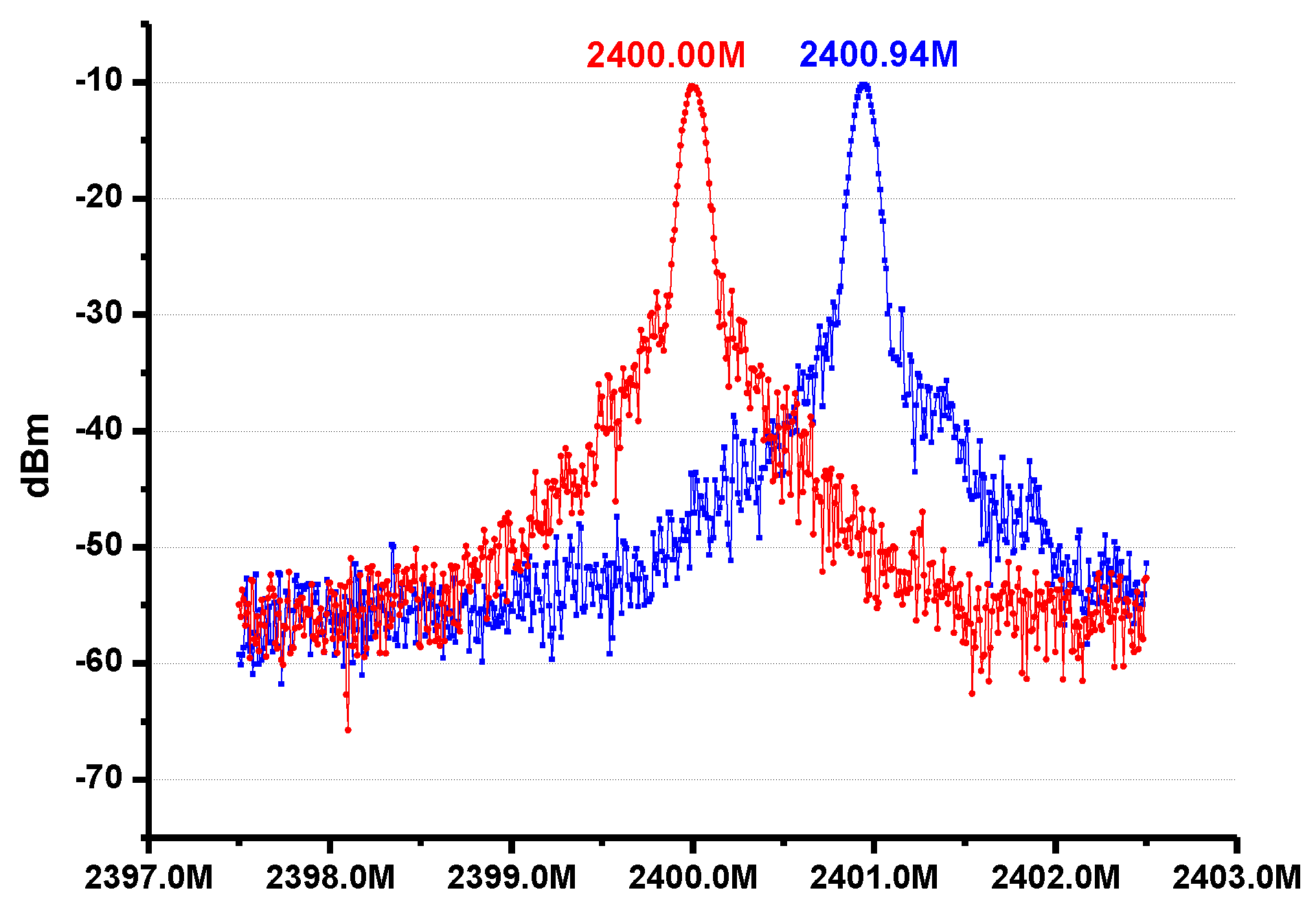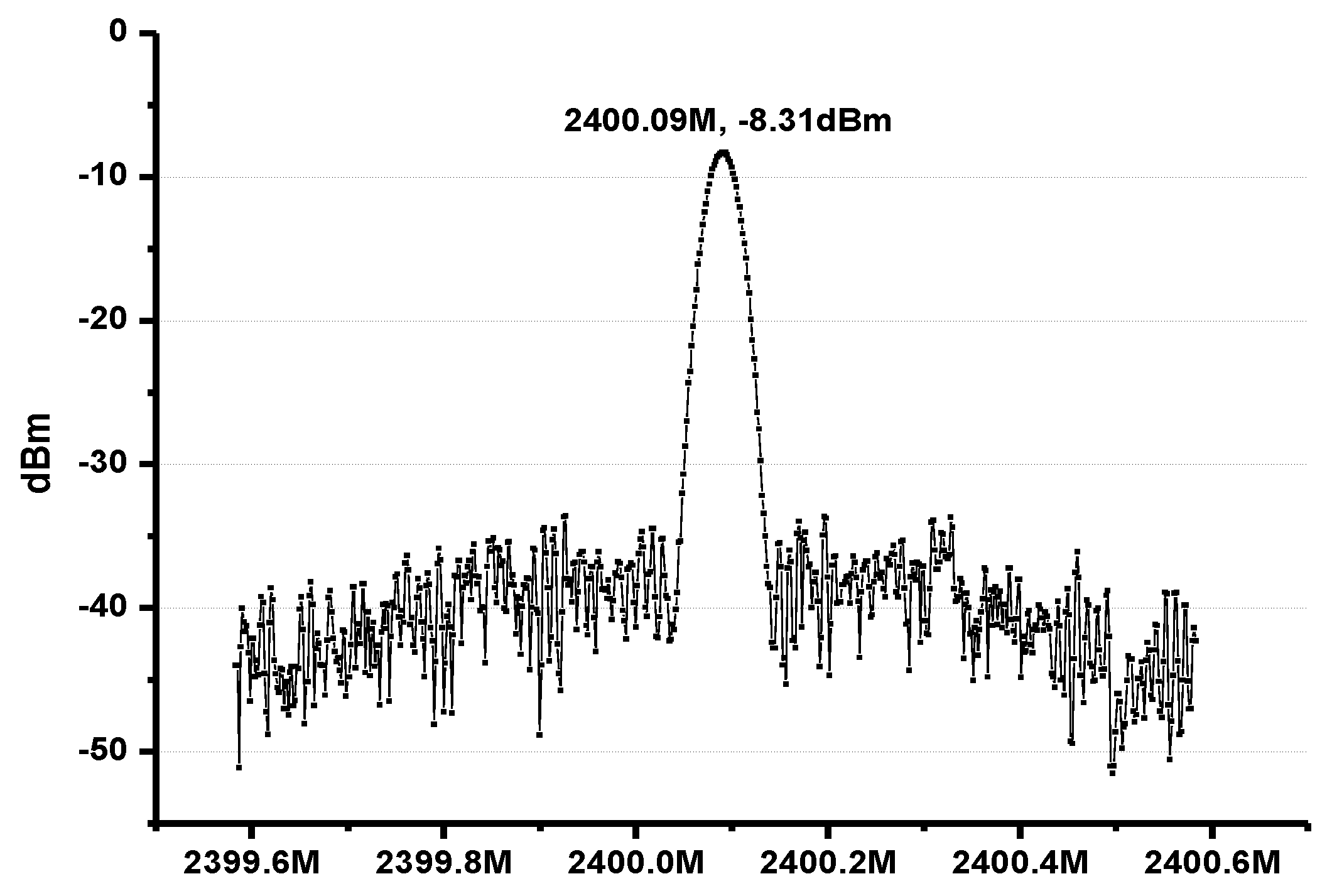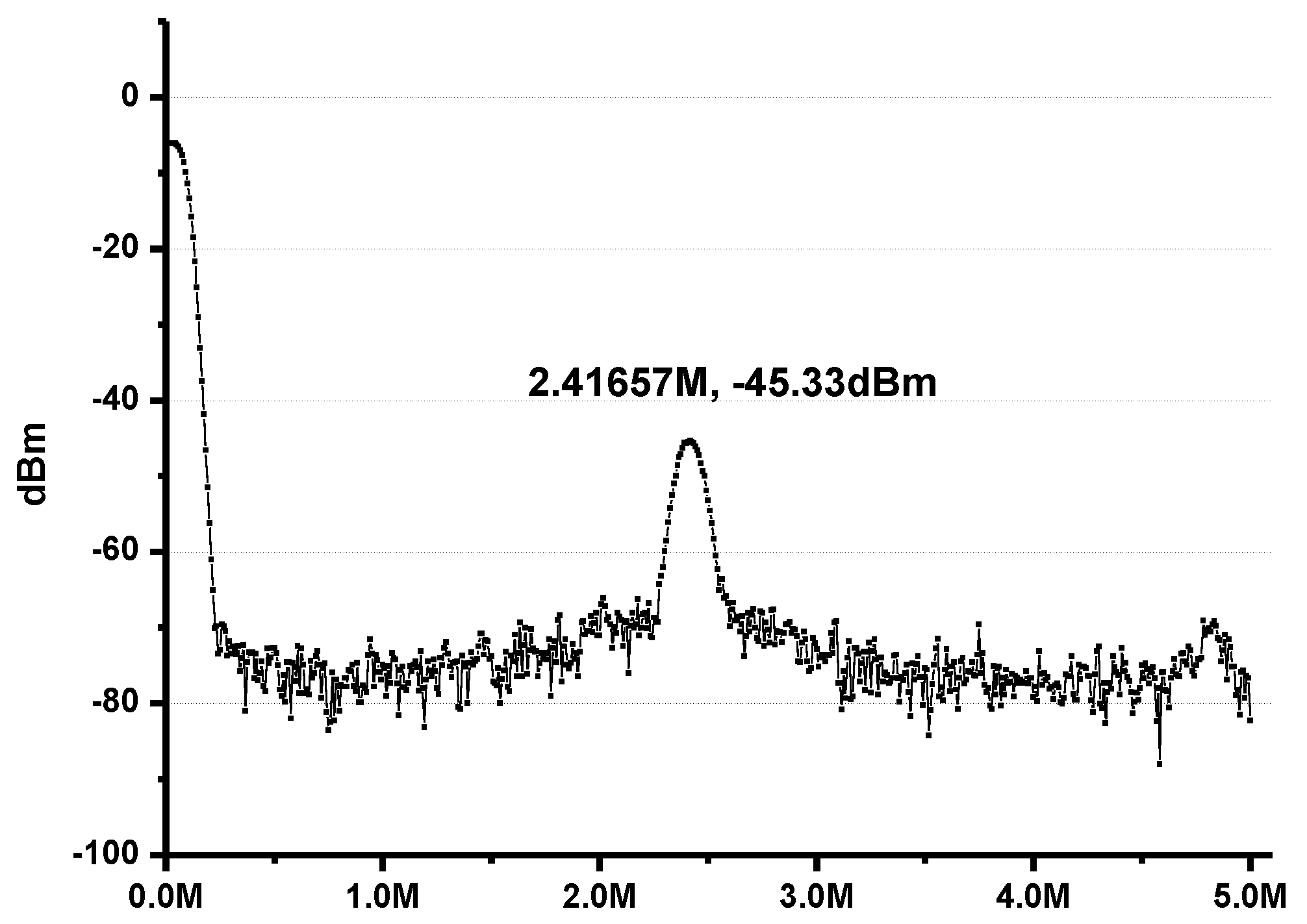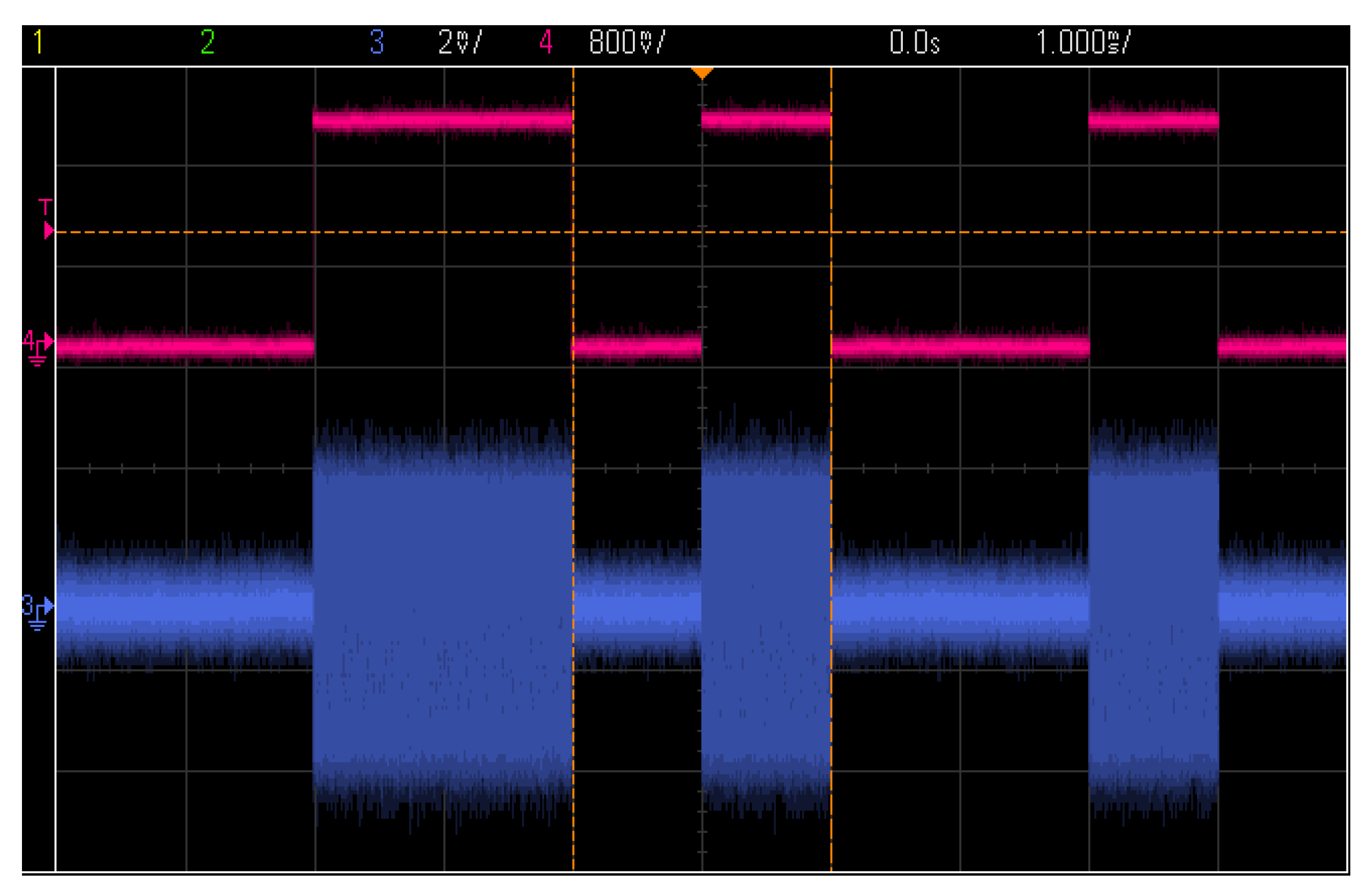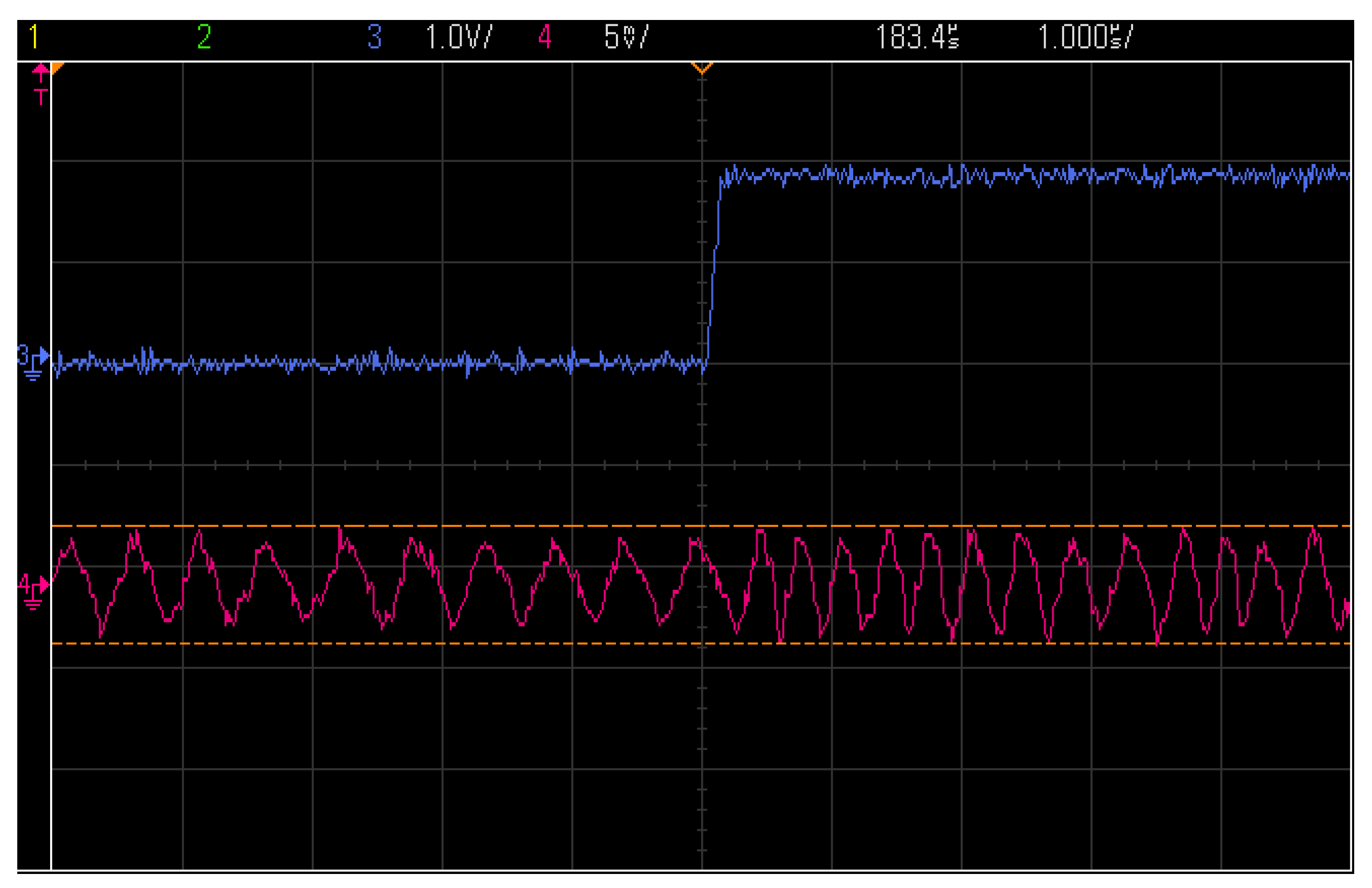3.1. Low Noise Amplifier and Power Amplifier
As illustrated in [
12], since the TX and RX share an antenna, the PA and LNA can be co-designed to share the matching network. The basic consideration is that when the LNA is in the off mode, the system is working as a transmitter. However, the LNA simultaneously contributes parasitic capacitance. Similarly, in the RX mode when the PA is powered off, the parasitic capacitance of the PA should be included in the simulation of LNA. The off-chip connection of the LNA/PA to the antenna is shown in
Figure 2.
Figure 3 shows the topology of the low noise amplifier and the power amplifier. It is an inductor reuse topology proposed in [
12]. As mentioned above, the key considerations in this transceiver are low cost (small silicon area) and flexibility in functionality subject to acceptable performances, such as noise figure, gain, and linearity. Hence, it is necessary to maintain less off-chip component and small silicon area. Additionally, it would be more attractive if the transceiver is able to be re-configured for different applications, since the WSN applications cover a wide range of operating frequencies. Thus, the strategy in this design is that the RX and TX are inductor-less and only one off-chip inductor is shared by the RX and TX. The silicon area of the transceiver will, therefore, be ultra-small. Moreover, since the matching network is determined by the inductor and capacitor, it will be very convenient to make the RX and TX work properly at the desired frequency range.
The PA in this design is a conventional class-E topology as shown in
Figure 3. It consists of three stages of inverters, the output stage has an output matching network with an on-chip capacitance and an off-chip inductor with capacitances, which forms a PI-matching topology. This topology, which is widely used in short-range communication exhibits a high efficiency and small silicon area. Additionally, the external matching network make it possible to re-configure the system at different working frequencies.
Figure 4 shows the simulation results of the PA, the maximum output power reaches 2.1 dBm, while the power added efficiency (PAE) is 21.2%.
Similarly, the LNA is designed to maintain a good balance among the required performances. To achieve a wide operating band, a common gate topology is implemented since a higher noise figure is acceptable in this system. The parallel resonant circuit shared with the power amplifier forms a band-pass frequency response which improves the robustness against interferences. Another important trade-off is the load of the amplifier. A resistive load, instead of a commonly-used inductive load, is implemented in this design in considering a small silicon area. The drawback of this design is the lower high-frequency gain, sizing of the transistors and resistors is, thus, carried out to ensure acceptable performances in noise figure, gain, and linearity at desired operating frequencies.
Figure 5 shows the simulation results of the low noise amplifier. It has a wide-band of gain performance, which is over 12 dB from several hundred megahertz to 3 GHz. The noise figure of the LNA is about 6–7 dB within the band of interest. The performances are quite acceptable for a complete receiver with a noise figure budget up to 20 dB. The Third Order Intercept Point (IP3) of the amplifier is higher than 0 dBm, which suggests that the RX exhibits good linearity.
3.3. Frequency Synthesizer
The frequency synthesizer has been a major bottleneck of fully-integrated transceivers [
14,
15]. Due to this large silicon area and power consumption, it is usually an off-chip sub-system in many ultra-low-power solutions. However, in this work, to ensure the robustness and maximized flexibility, it is designed as a fully-integrated sub-system which provides frequency outputs fractional to the reference clock. It includes a voltage-controlled oscillator, a fractional-N frequency divider, a phase-frequency detector, a charge pump and a loop filter as shown in
Figure 1.
The voltage-controlled oscillator is the key building block in terms of working range, phase noise, and output power of the PLL. The key considerations are acceptable phase noise with low power consumption and small silicon area. To improve the power efficiency, the PMOS-NMOS cross-coupled negative-G
m LC oscillator is used as shown in
Figure 7. The optimization is mainly focused on the high-performance LC tank. The oscillator has a start-up condition which is determined by the quality of the tank and the negative G
m to compensate the tank loss, which suggests that low power is only possible for a high quality factor (Q) tank. At 2.4 GHz range, the low quality factor of inductor is the major concern. A high Q can be obtained using an off-chip inductor, but it is susceptible to additional parasitic effects in the package and on the PCB. In this work, properly sizing of this on-chip fully-symmetrical inductor is used to ensure a high-quality factor (around 10) at the desired frequency range. The overall quality factor of the LC tank is about 6–7. After optimization, the biasing current of 0.7 mA is able to ensure a robust operation of the oscillator (three times higher than the start-up condition in G
m). In additional to the varactors for continuous frequency tuning, a three-bit digitally-controlled capacitance bank is implemented so that the proposed VCO can work properly from 2.2 GHz to 2.6 GHz. The gain of the VCO (K
VCO) is designed to be less than 100 MHz/V to maintain a good phase noise performance, while covering the 2.4 GHz operating band with certain redundancy. The output power of this VCO (with an output buffer) is around 3 dBm. The simulated F-V curve of the VCO is shown in
Figure 8. As shown in
Figure 8, the simulated phase noise of the VCO is −113 dBc/Hz at 1 MHz offset.
Another key building block is the frequency divider. As shown in
Figure 9, it includes a divide-by-two prescaler, a divide-by-4/5 prescaler, and the P counter with division ratios of 14, 15, and 16. The total division ratio is 2 × (52 + M), where is M is fractional number, which is controlled by a 10-bit sigma-delta modulator (configured as Mash 1-1-1); considering the short-range communication with low power and small silicon area, even the fractional spur can be quite high due the insufficient random dithering. Another key consideration is the power consumption [
14]. In this work, the blocks in the frequency divider are designed to be power efficient at the certain working frequencies. The prescaler is the most challenging building block in the frequency divider since it works at the highest operating frequency. The MOS current mode logic (MCML) is the most popular solution at the operating frequency above 1 GHz. However, it is quite power consuming compared with dynamic digital logic such as true-single-phase-clock (TSPC). Therefore, it is preferred that the MCML circuit is only implemented at the highest operating frequency, while the lower frequency division is performed with single-ended logic. In this work, to maintain a good balance between operating frequency and power consumption, the input signal is firstly divided by two using a MCML divider followed by a differential-to-single-ended buffer (CML-Dig in
Figure 9). The MCML divide-by-two unit is shown in
Figure 8b, which consists of two D-latches. The voltage swings of the input and output of the divide-by-two unit are about 600 mV (peak-to-peak). After a MCML-to-digital buffer, which is a differential to single-ended unit, the output becomes a rail-to-rail signal. Since the output frequency is now about 1.2 GHz, it is possible to use more power efficient logic, namely the TSPC logic in the following divide-by-4/5 prescaler, which is shown in
Figure 9c. The D flip-flop used in this design is the conventional nine-transistor TSPC topology [
13]. Finally, the output of the divide-by-4/5 prescaler is less than 400 MHz so that the following frequency division can be performed by the divide-by-14/15/16 counter implemented using standard static CMOS logic, which is stable and easy to implement. The total division ratios are determined by four bits of modulus control signals, which are connected to a sigma-delta modulator. In this system, the modulator is of three stages (in Mash 1-1-1) each of which is a 10-bit configuration. The total division ratio is set to be (2 × (52 + M)), where M is a programmable fraction number. Using this fractional-N topology, it is able to achieve division ratios which is a fractional, instead of an integer, number. It is now possible to use a higher reference clock for the PLL system, which results in fast settling time and maximized functionality.
The other building blocks in the PLL, as shown in
Figure 10, are quite conventional. The PFD is a dead zone-free digital detector and the charge-pump (CP) is a conventional one, as shown in
Figure 10. The charge current is about 100 μA. A third-order RC-based loop-filter is used for better suppression of the reference spurs. In this work, key consideration is that the capacitor should be small enough to have a fully-integration solution. The parameters of the components in the loop filter are determined by the closed-loop transfer function of the PLL [
15]. The whole PLL system is now a fourth-order system [
13]. Since the gain of the VCO frequency tuning, operating frequency, division ratio, and charge current have been determined, the PLL has the freedom in optimization of loop filters. As the key target is the silicon area which is occupied by the loop capacitor. In this design, the maximum capacitance after optimization is 60 pF, which occupies 240 μm × 200 μm. The loop bandwidth is 500 kHz to suppress the Delta Sigma Modulator (DSM) quantization noise.
Simulation of the PLL is carried out using Cadence Spectre RF (San Jose, CA, USA) at the transistor-level in a 0.18 μm CMOS technology (post-layout). Simulation suggests that the proposed PLL is able to work at 2.4 GHz with less than 20 μs settling time, as shown in
Figure 11.
3.4. System Level Integration
In addition to the key building blocks, there are also some other circuits in the proposed system. The most important part is serial peripheral interface (SPI) circuit, since many circuits in the system are configurable. For example, the transceiver can be configured as an RX or TX, and the gain of the RX is programmable. In addition, by changing the division ratios, which are equal to 2 × (52 + M), the output frequency of the PLL is configurable to support different channels. Accordingly, the working bands of the voltage controlled oscillator should be adjusted to support the desired operating frequencies. The SPI occupies a silicon area of 240 μm × 80 μm (0.0192 mm2). The SPI has 32 bits, while 24 of them are used to control the transceiver. D0–D2 are used to control the cap array. D3–D4 control the frequency division of the integer divider. D5–D14 control the frequency division of the fractional divider. D15 is the enable bit of PLL. D16–D19 are used to switch the gain of the IF amplifier. D20 enables the receiver. D21 enables the power amplifier. D22 enables FSK modulate of the transmitter. D23 enables FM modulate of the transmitter. By designing SPI circuit, all of the control bits can be set by several on-chip registers.
Finally, as a complete chip, it includes some functional building blocks, such as the biasing circuits, crystal buffer, and decoupling capacitors. The crystal buffer is designed to support an off-chip crystal of 20 MHz (to meet 2.4 GHz PLL output frequency range). De-coupling capacitors between the supply voltage and ground are added (as many as possible) to improve the noise performance. Implemented using a 0.18 μm CMOS technology, the layout of the transceiver is about 0.7 mm × 0.7 mm and the full chip is about 1.1 mm × 1.1 mm with the added capacitors and ESD pads.

